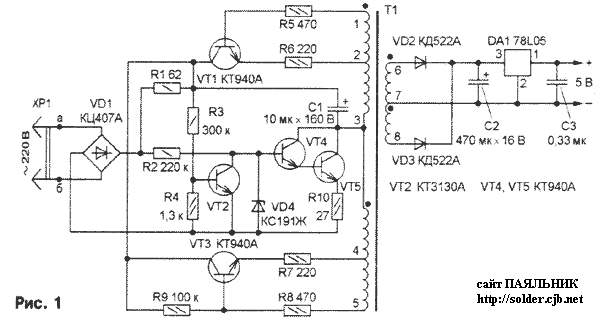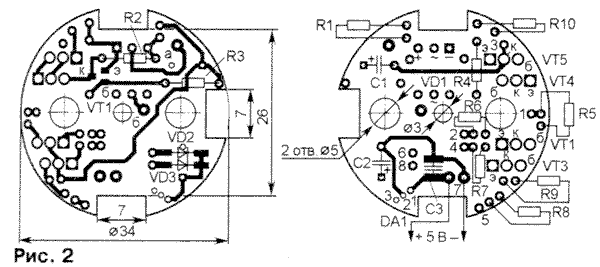
|
|
ENCYCLOPEDIA OF RADIO ELECTRONICS AND ELECTRICAL ENGINEERING Miniature power supply 5-12 volts. Encyclopedia of radio electronics and electrical engineering
Encyclopedia of radio electronics and electrical engineering / Power Supplies The proposed block is intended for power supply from a network of small-sized radio-electronic devices (pocket radios, voice recorders, watches, etc.). The output voltage can be selected in the range from 5 to 12 V. One of the advantages of the block is its small dimensions: all its parts are placed in the housing ... of the mains plug. The main technical characteristics of the described power supply are as follows. mains voltage - from 100 to 250 V with a frequency of 50 ... 500 Hz, output voltage (depending on the integrated stabilizer used) - from 5 to 12 V, rated load current (at an output voltage of 5 V) - 20, maximum (at the same voltage) - 100 mA, ripple level (at rated current) - no more than 1%. The schematic diagram of the block is shown in fig. 1. It works as follows.
The mains voltage rectified by the diode bridge VD1 is fed through the divider R1 R3R4 to the base of the transistor VT2, and through the resistor R2 to the base of the composite transistor VT4, VT5. During each half-cycle, while the voltage at the connection point of the collectors VT1, VT3 relative to the emitter VT2 does not exceed 100 V, it is closed, VT4VT5 are open and the capacitor C1 is charged through resistors R1, R10 and the emitter-collector section of the transistor VT5. When the voltage at the specified point is above 100 V, VT2 opens and shunts the emitter junction of the composite transistor. Capacitor C1 is discharged, feeding the oscillator on transistors VT1, VT3, assembled according to the Roer scheme (see the book by Ivanov-Tsyganov A.I. and Khandogin V.I. "Sources of secondary power supply for microwave devices". - M .: Radio and communication, 1989) . The oscillation frequency of the oscillator is approximately 60 kHz. A voltage of about 1 V is removed from the secondary winding of the transformer T7. It is rectified by the diodes VD2, VD3, smoothed by the capacitor C2 and stabilized by the integral stabilizer DA1. Capacitor C3 reduces high frequency ripple. The maximum voltages of the collector-emitter of transistors VT1, VT3 in steady state do not exceed 200 V, VT4 and VT5 - 210 V. The maximum current of the transistor VT5 with the ratings of the elements indicated on the diagram and the static current transfer coefficient of the base h21e of transistors VT4, VT5, equal to 25, does not exceed 300 ma. At the moment of switching on, the collector-emitter voltage of transistors VT4 and VT5 can exceed 300 V. and the collector current VT5 is 0,5 A, which will lead to their failure. To limit the collector current VT5 at this moment (when using transistors VT4 and VT5 with a large coefficient h21e), resistor R10 and a zener diode VD4 are used. To limit the collector-emitter voltage of a composite transistor, it is desirable to turn on a varistor for a voltage of about 5 V between the collector and emitter of VT250. When using the unit to power a low-power load (with a current consumption of not more than 5 ... 10 mA), it is advisable to increase the resistance of resistors R6 and R7 to 470 Ohms, and reduce the capacitance of capacitor C 1 to 2,2 ... 4,7 μF (in this In this case, the unit will heat up less and the reliability of its operation will increase). In addition to KT3130A (VT2), any transistor of this series, as well as the KT3102 series or foreign-made ones with similar characteristics (for example, BCW60D) can be used in the device. Transistors KT940A are interchangeable with KT969A, BF469 / PLP (VT1, VT3) or KT969A, BF459 (VT4, VT5).
Capacitors C1, C2 - imported, it is possible to use K50-35, C3 - K10-17. Diodes VD2, VD3 - any small-sized silicon with a permissible forward current of at least 100 mA, a reverse voltage of at least 20 V and an operating frequency of at least 150 kHz. Resistors R1 -R3 - C 1 -4, BC or others with an operating voltage of at least 350 V, the rest - C2-33, C2-23, MLT, OMLT or the like. Transformer T1 is wound on two ferrite (2000NM) rings folded together, size K10x8x3. Windings 1-2 and 4-5 contain 8 turns of wire PEV-1 0,1, 2-3 and 3-4 - 200 turns of the same wire each, windings 6-7 and 7-8 - 14/22/28 each turns PEV-1 0,17 (respectively for output voltages 5/9/12 V). For interwinding and external insulation, it is recommended to use fluoroplastic film or PET film. In the author's version, the power supply is mounted in a standard power plug with a diameter of 40 and a height of 27 mm. The printed circuit board (Fig. 2) is made of double-sided foil fiberglass with a thickness of 0,5 mm. The distance between the centers of the holes in the board for the pins of the mains plug is 19 mm. All resistors, except R2 and R3, are installed perpendicular to the board. The zener diode VD4 is soldered to the printed conductors from the mounting side of the transistor VT2. To the pads marked with the letters "a" and "b", solder the wires coming from the pins of the mains plug, and to the pads with the numbers 1-7 - the conclusions of the windings of the transformer T1. Place it above the capacitor C3 in the free space between the transistors VT1, VT3 and capacitor C2. Assembled from serviceable parts and without installation errors, the unit does not require adjustment. Author: A. Khabarov, Kovrov, Vladimir Region; Publication: cxem.net
Machine for thinning flowers in gardens
02.05.2024 Advanced Infrared Microscope
02.05.2024 Air trap for insects
01.05.2024
▪ Photon camera tracks endoscope in human body ▪ Self-learning photonic computer ▪ Portable projector ASUS ZenBeam L2 ▪ NLAS2066 - analog switch for separating USB lines and standard logic
▪ site section Frequency synthesizers. Selection of articles ▪ article This mystery is great. Popular expression ▪ How did fruits and vegetables get their names? Detailed answer ▪ article Radiologist of the X-ray department (office). Job description ▪ article Amplitude, average, effective. Encyclopedia of radio electronics and electrical engineering ▪ article Blooming flower. Focus secret
Home page | Library | Articles | Website map | Site Reviews www.diagram.com.ua |






 Arabic
Arabic Bengali
Bengali Chinese
Chinese English
English French
French German
German Hebrew
Hebrew Hindi
Hindi Italian
Italian Japanese
Japanese Korean
Korean Malay
Malay Polish
Polish Portuguese
Portuguese Spanish
Spanish Turkish
Turkish Ukrainian
Ukrainian Vietnamese
Vietnamese


 Leave your comment on this article:
Leave your comment on this article: